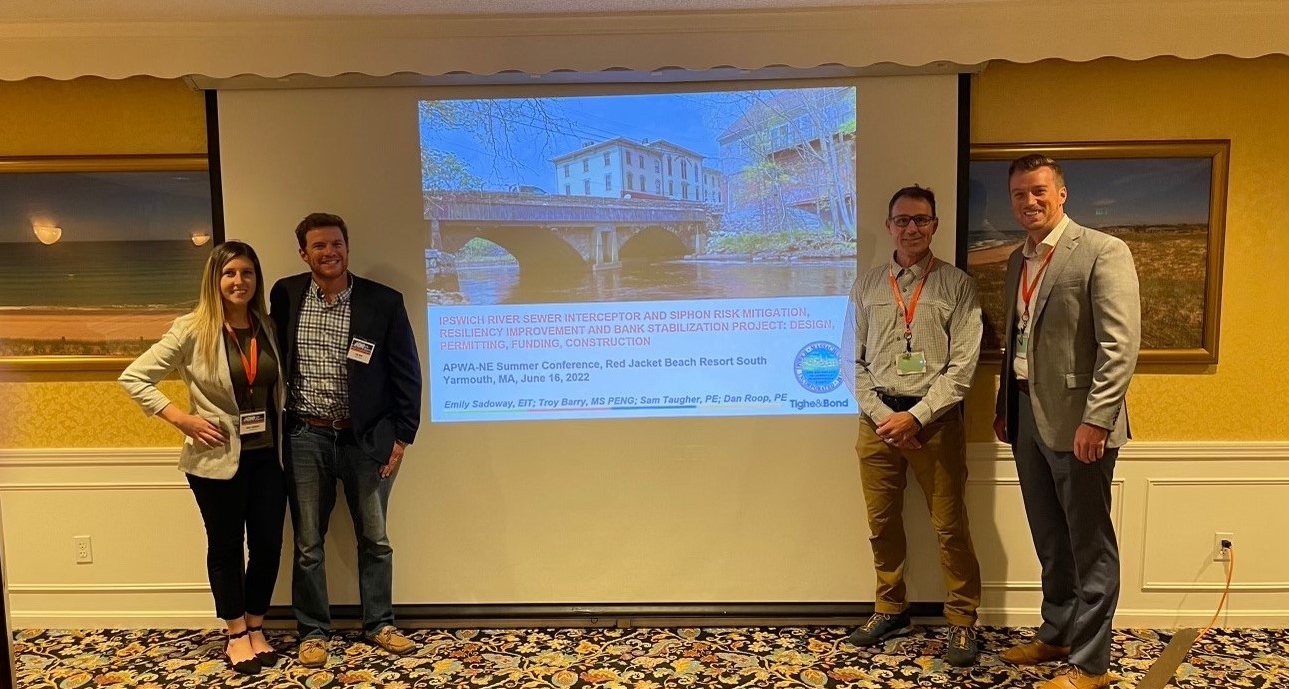APWA New England Summer Conference

Left to Right: Emily Sadoway, Water/Wastewater Engineer – Ipswich Utilities, Daniel Roop, PE, Project Manager, Troy Barry, MS, PE, Principal Engineer – Tighe &
Bond, Sam Taugher, PE, Project Engineer.
Our engineers Troy Barry, MS, PE, Daniel Roop, PE, and Sam Taugher, PE teamed up with Ipswich, MA Water/Wastewater Engineer Emily Sadoway to present at the American Public Works Association‘s Summer Conference on June, 16th. The team of engineers spoke about the Ipswich sewer interceptor and siphon risk mitigation, resiliency improvements, and bank stabilization project.
In 2021, the Town of Ipswich Utilities Department implemented a plan to address rising sea levels that were eroding the banks of the Ipswich River which contain sewer siphons and interceptors running parallel alongside the river. Bank erosion and potential failures increase the risk of exposing these pipes leaving them susceptible to damage. A sewage leak would be detrimental to the river, the clam flats, and human health. The banks of the Ipswich River have traditionally been heavily riprapped with very large angular rock but were showing signs of erosion and vegetation loss in several locations.
The project team took a living shoreline bioengineering approach focused on a hybrid of toe stone with low marsh through tidal buffer zone plantings along the river streambank. The project’s biostabilization plan implemented nature-based solutions to not only stabilize the banks from further erosion but provide biological uplift for river riparian and aquatic communities. The natural systems approach utilizes biomimicry and ecosystem adaptation through the use of coconut coir-wrapped soil lifts for a range of tidal and runoff channel flows, and low tide through mean high tide elevation. Salt-tolerant native plantings were added to reestablish the low marsh and high marsh riparian zone and provide habitat and bank erosion resiliency while also protecting the critical sewer infrastructure.
This project solved multiple concerns and included the following elements:
- Replacing the existing sewer siphon near the Choate Bridge with a new triple-barrel siphon and installing a watertight sewer manhole cover
- Rehabilitating and physically protecting the sewer interceptor from climate hazards
- Pedestrian access to the river
- Removal of invasive species and revegetation with native plantings and shrubs resulted in improved water and air quality, stabilized the soil and bank, provided habitat, and further enhanced the waterway as a scenic community asset.
- The project improved resiliency to a portion of the riverbank along the Ipswich River, where increased river velocities and debris from sea level rise and intense rain events have eroded and will ultimately expose and could compromise the integrity of the infrastructure. This nature-based bank protection is designed to provide stabilization to the banks along the infrastructure, adjacent environment, and properties in an adaptable more resilient manner from extreme weather-related events.
Additionally, our engineers and landscape architects from Halvorson |Tighe & Bond Studio recently led a site walk for the project. Members of the Ipswich Council on Aging and other community members were taken on a tour of the project and discussed how the design limits the effects of climate change on downtown Ipswich, MA.


